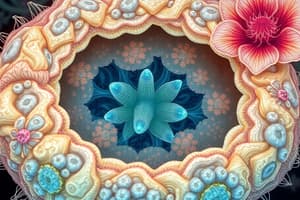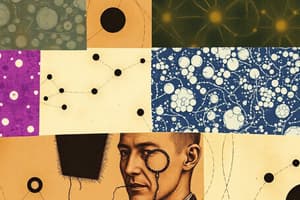Podcast
Questions and Answers
What are the primary components of an animal cell that differentiate it from a plant cell?
What are the primary components of an animal cell that differentiate it from a plant cell?
Animal cells primarily have a nucleus, cytoplasm, and cell membrane but lack a cell wall and chloroplasts.
Why might root cells not contain chloroplasts despite being plant cells?
Why might root cells not contain chloroplasts despite being plant cells?
Root cells do not contain chloroplasts because they are not exposed to light and do not carry out photosynthesis.
Explain the significance of cell division in living organisms.
Explain the significance of cell division in living organisms.
Cell division is essential for producing new cells and replacing damaged ones, ensuring growth and maintenance of tissues.
Describe the function of chlorophyll in leaf cells.
Describe the function of chlorophyll in leaf cells.
What role do guard cells play in a plant?
What role do guard cells play in a plant?
What unique feature distinguishes red blood cells from other cell types?
What unique feature distinguishes red blood cells from other cell types?
What defines a cell and what types of cells are there?
What defines a cell and what types of cells are there?
Identify one major similarity and one major difference between animal cells and plant cells.
Identify one major similarity and one major difference between animal cells and plant cells.
What is the primary role of the cell membrane?
What is the primary role of the cell membrane?
Explain the function of chloroplasts in plant cells.
Explain the function of chloroplasts in plant cells.
What is the composition and function of cytoplasm in a cell?
What is the composition and function of cytoplasm in a cell?
Describe the role of the nucleus in a cell.
Describe the role of the nucleus in a cell.
What are the functions of the cell wall in plant cells?
What are the functions of the cell wall in plant cells?
Why are chloroplasts green and what role does chlorophyll play?
Why are chloroplasts green and what role does chlorophyll play?
Flashcards are hidden until you start studying
Study Notes
Cell Overview
- Cells are the basic units of life; can be classified as animal or plant cells.
- Multi-cellular organisms are composed of many cells.
Similarities Between Animal and Plant Cells
- Both types contain cytoplasm, a cell membrane, and a nucleus.
Differences Between Animal and Plant Cells
- Plant cells have additional structures: chloroplasts for photosynthesis and a rigid cell wall for support and shape.
- Animal cells lack chloroplasts and a cell wall.
Cytoplasm
- Jelly-like substance within the cell, primarily composed of water and nutrients.
- Facilitates movement of substances and supports chemical reactions within the cell.
Nucleus
- Acts as the control center of the cell, regulating all cellular activities.
- Contains hereditary genetic information passed from parents to offspring.
Cell Membrane
- Regulates material movement (water, nutrients, and waste) in and out of the cell.
- Provides protection and structural support.
Cell Wall
- Found in plant cells; offers support and maintains cell shape.
- Controls the movement of substances and is composed of rigid materials allowing plants to retain shape.
Chloroplast
- Organelle responsible for photosynthesis, capturing sunlight to produce food.
- Contains chlorophyll, the pigment that gives it a green color and plays a role in trapping sunlight.
Misconceptions About Cell Size
- Larger organisms do not necessarily have larger cells; cell size is independent of organism size.
Specific Components of Animal and Plant Cells
- Plant cells include nucleus, cytoplasm, cell membrane, chloroplasts, and cell wall.
- Animal cells contain nucleus, cytoplasm, and cell membrane but lack chloroplasts and cell walls.
Cell Division
- Essential for producing new cells and replacing damaged ones.
Leaf Cells
- Contain chlorophyll for sunlight absorption to produce food through photosynthesis.
Guard Cells
- Regulate the opening and closing of stomata, controlling gas exchange.
Root Cell Efficiency
- Long shape with a large surface area enhances absorption of water and minerals from the soil.
Unique Features of Red Blood Cells
- Lack a nucleus, allowing for more space to transport oxygen.
Cell Types Recognition
- Leaf cells identified by chloroplast presence, root cells recognized by shape, and cheek cells by visible nucleus and membrane.
Studying That Suits You
Use AI to generate personalized quizzes and flashcards to suit your learning preferences.




